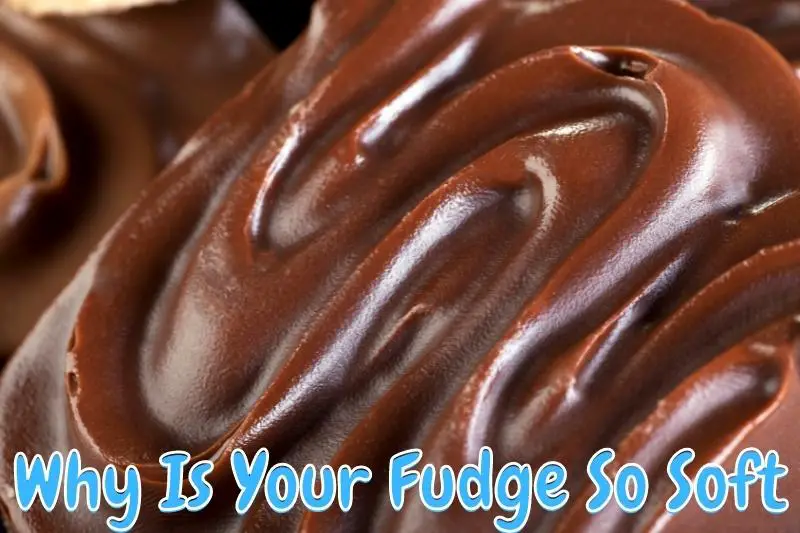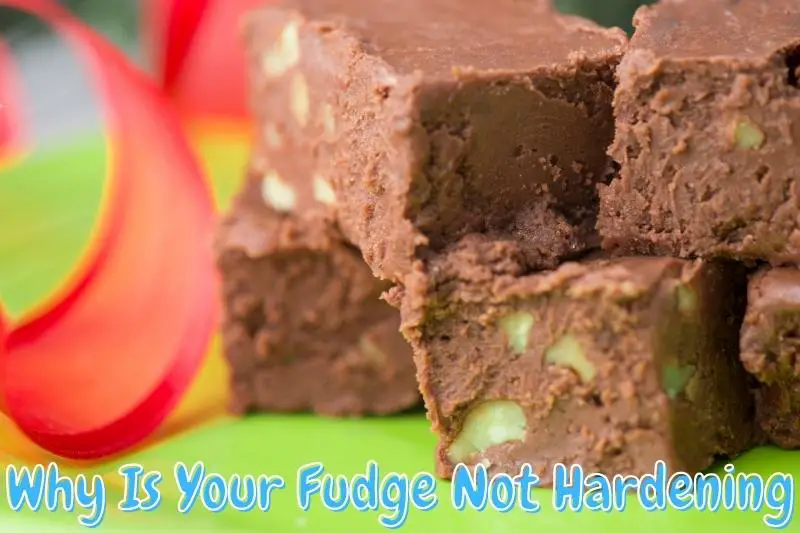This post contains affiliate links.
It’s happened to all of us. You’re making your favorite batch of fudge, and it just doesn’t seem to be set right. It’s soft, mushy, and generally not very appealing. So why does this happen? Why does your fudge turn out soft instead of the desired firm and creamy consistency?
The main reason for soft fudge is undercooking. If the fudge didn’t get hot enough or didn’t cook long enough, it won’t set properly. You can fix soft fudge by adding powdered sugar and boiling it for a few more minutes. You can prevent soft fudge by following the recipe’s cooking time precisely.
I will list some other possible causes for soft fudge below, as well as some tips on how to prevent soft fudge from ever happening again in the future.
Why Did My Fudge Come Out Too Soft?
Fudge is meant to be this delicious and indulgent treat. When eating, it has a firm bite to it but is still creamy. If your fudge is coming out too soft, don’t fret! There are a few reasons why it’s soft and a solution to each.

*By the way, if you’re looking for a good mold to make your fudge in, I’ve recently come across the perfect Silicone Fudge Mold made from small rectangles. This Silicone Mold was perfect for my fudge bites dessert! You can check out this Fudge Mold on Amazon!
Here are the most common reasons for soft fudge:
You Didn’t Cook It Long Enough
Not cooking the fudge long enough is the most common cause of soft fudge. Make sure you follow the recipe to the letter and cook it for the specified amount of time.
It Didn’t Cook At A High Enough Temperature
If your thermometer isn’t working properly, or if you didn’t let the fudge come to a boil for long enough, it can also cause the fudge to be too soft.
Your fudge needs to get hot enough so that the water evaporates and the sugar crystals have a chance to form.
You Stirred It Too Much
Stirring the fudge too much can also prevent it from setting properly. Once you’ve added the butter and milk, Stir gently until combined, then stop stirring and let it cook.
You want to make sure you beat the fudge until it’s smooth and creamy, but stirring it too much after that can make it too soft.
You Added Too Much Liquid
If you add too much milk or cream to the fudge mixture, it can make the fudge softer. Stick to the recipe and don’t add more liquid than it calls for.
Underbeating Cooked Fudge
You know fudge has to be beaten once it’s cooked, but you might not know that under-beating it can also make it softer.
Note, however, that beating the fudge too much is going to make it too hard, so don’t overdo it. Just beat it until it’s light and fluffy, and no longer glossy.
Not Using The Right Ingredients
Not using the right ingredients is another common cause of soft fudge. Make sure you’re using fresh, high-quality ingredients, and that you measure them accurately.
*By the way, I recently wrote an article about Why Did Your Fudge Get So Hard? This article talks about all the reasons why your fudge gets hard as well as how to fix and prevent it so that it never happens again. You can check out this article here!
Should Fudge Be Hard Or Soft?
As a whole, properly prepared fudge should be just soft enough to be easily cut with a knife, but firm enough to hold its shape. It should also be smooth and creamy, with no graininess. If fudge is too hard to bite into, it is probably from not using enough liquid ingredients or overbeating the fudge.
I have seen recipes that call for the fudge to be “beaten until stiff,” but I don’t recommend this. The fudge will be very hard to cut and eat, and it’s more likely to crack.

Fudge that’s too soft will look mushy and will be difficult to cut into neat pieces. It might also be overly sweet and sticky. You want to make sure to strike a balance between too hard and too soft.
I often do this by following the recipe to the letter, then cooking it for a minute or two less than it calls for. This way, the fudge is soft enough to be creamy and smooth, but firm enough to hold its shape.
*By the way, I recently wrote an article about The Best Ways To Thicken Your Fudge When It’s Runny. This article breaks down everything you can do to thicken your fudge the right way. You can check out this article here!
How Do You Fix Soft Fudge?
As a whole, you can fix soft fudge by cooking it for a few more minutes. Put the gooey mixture back into the pot and add some water (about 1/2 of a cup) and heat it on medium-low, stirring constantly until it comes to a boil again. Once the water boils out, allow cooling before beating the fudge.
Let the fudge cool for about 15 minutes before beating it to the desired consistency. If it’s still too soft, you can repeat this process until it firms up.
You can also fix soft fudge by adding some confectioners’ sugar to it. Put the soft fudge in a bowl and add about a cup of sugar, then beat it until it’s combined. This will make the fudge firmer and easier to work with.
*Side Note: You might also want to know How To Make Fudge Without Condensed Milk. I recently wrote an article talking about what you must know when Making Fudge Without Condensed Milk, which you can check out here!
How Do You Prevent The Fudge From Being So Soft?
As a general rule, preventing soft fudge can be done by making sure you cook it long enough and at the right temperature. This way, the water in the fudge will evaporate and the sugar will have a chance to form properly. If the fudge is undercooked, the liquids will prevent the fudge from thickening.
You also want to make sure you don’t add too much liquid, and that you beat the fudge until it’s light and fluffy.
Once it’s cooked, let it cool for 15 minutes before beating it to the desired consistency.
Using the right ingredients is another way to prevent soft fudge. Make sure you’re using fresh, high-quality ingredients, and that you measure them accurately. Once the fudge is cooked, be sure to beat it long enough so that it sets properly.
Why Is My Fudge Not Hardening?
Generally speaking, the most possible reason why your fudge is not hardening is that it didn’t reach the right temperature, and thus the sugar crystals didn’t have time to form properly. These sugar crystals are important to form because of the integrity it brings to the fudge.
Another reason might be that you used a lot of liquid ingredients, which can prevent the fudge from hardening. Make sure to follow the recipe and only use the amount of liquid called for.

Let the fudge cook at the required temperature and for the specified time to give the sugar crystals a chance to form properly. This will help the fudge set and harden as it should.
I recently came across an 80-Cavity Square Candy Silicone Molds on Amazon. This candy mold works perfectly for hardening Leftover Melted Chocolate while giving you 80 potential chocolate candies to enjoy.
FAQs
How long does it take fudge to harden?
Depending on the amount of fudge you are making, it typically takes fudge anywhere from 3 hours minutes to overnight to harden properly once it has been thickened. After the cooldown process, the fudge is beaten and allowed to harden.
Does fudge harden in the fridge?
Generally speaking, fudge hardens in the fridge. you can place your fudge in the fridge to help it harden, but make sure to wrap it tightly in an airtight container or storage bag. Fudge can also be left at room temperature to harden but takes a bit longer to set.
Can I put fudge in the freezer to set?
Fudge can be placed in the freezer to set but with some precautions. Setting fudge in the freezer should be done by wrapping it tightly so that it does not absorb moisture or any other flavors from the freezer. Wrap tightly with plastic wrap and place into an airtight container.
What should the texture of fudge be?
The texture of fudge should be smooth and creamy, with no graininess. It should also be just soft enough to be easily cut with a knife, but firm enough to hold its shape. Make sure it is not crumbly because fudge should have good integrity and can hold its shape.

How do you thicken fudge that won’t set?
A quick and easy way to thicken fudge that won’t set is to add Confectioners sugar or powdered sugar. Add one tablespoon of powdered sugar and combine with the fudge. If it is still not set, add a tablespoon at a time until you get the proper consistency. You can also use cornstarch to thicken.
Why is my fudge soft and sticky?
As a general rule, if your fudge is both soft and sticky it is because of undercooking. When fudge isn’t heated for the correct amount of time, the water inside doesn’t evaporate which causes a soft fudge. The stickiness comes from not heating the fudge enough and not for long enough.
How long should you boil fudge?
Generally speaking, boiling fudge should be done until it reaches a temperature of 234°F. Making sure to occasionally stir, the fudge should be at boiling until the correct temperature which can be measured using a candy thermometer. Once done, lower to medium-low heat.
Do you cover fudge while it sets?
As a general rule, you should not cover the fudge as it sets. As the fudge is still cooling, covering it would prevent heat from escaping which would prevent it from hardening properly. Instead, leave uncovered at room temperature. Once cooled, you may cover and place it in the fridge.
